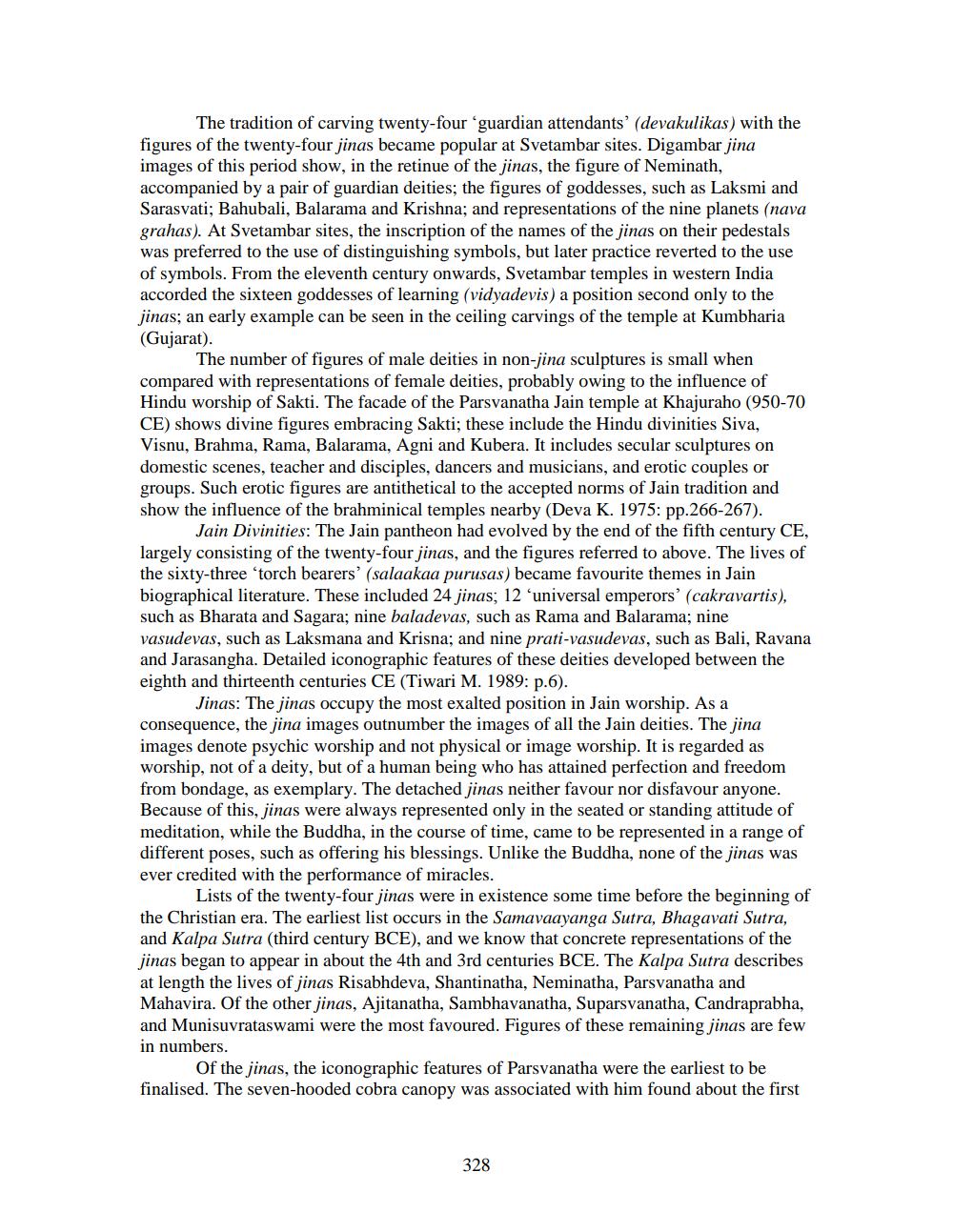________________
The tradition of carving twenty-four 'guardian attendants' (devakulikas) with the figures of the twenty-four jinas became popular at Svetambar sites. Digambar jina images of this period show, in the retinue of the jinas, the figure of Neminath, accompanied by a pair of guardian deities; the figures of goddesses, such as Laksmi and Sarasvati; Bahubali, Balarama and Krishna; and representations of the nine planets (nava grahas). At Svetambar sites, the inscription of the names of the jinas on their pedestals was preferred to the use of distinguishing symbols, but later practice reverted to the use of symbols. From the eleventh century onwards, Svetambar temples in western India accorded the sixteen goddesses of learning (vidyadevis) a position second only to the jinas; an early example can be seen in the ceiling carvings of the temple at Kumbharia (Gujarat).
The number of figures of male deities in non-jina sculptures is small when compared with representations of female deities, probably owing to the influence of Hindu worship of Sakti. The facade of the Parsvanatha Jain temple at Khajuraho (950-70 CE) shows divine figures embracing Sakti; these include the Hindu divinities Siva, Visnu, Brahma, Rama, Balarama, Agni and Kubera. It includes secular sculptures on domestic scenes, teacher and disciples, dancers and musicians, and erotic couples or groups. Such erotic figures are antithetical to the accepted norms of Jain tradition and show the influence of the brahminical temples nearby (Deva K. 1975: pp. 266-267).
Jain Divinities: The Jain pantheon had evolved by the end of the fifth century CE, largely consisting of the twenty-four jinas, and the figures referred to above. The lives of the sixty-three 'torch bearers' (salaakaa purusas) became favourite themes in Jain biographical literature. These included 24 jinas; 12 'universal emperors' (cakravartis), such as Bharata and Sagara; nine baladevas, such as Rama and Balarama; nine vasudevas, such as Laksmana and Krisna; and nine prati-vasudevas, such as Bali, Ravana and Jarasangha. Detailed iconographic features of these deities developed between the eighth and thirteenth centuries CE (Tiwari M. 1989: p.6).
Jinas: The jinas occupy the most exalted position in Jain worship. As a consequence, the jina images outnumber the images of all the Jain deities. The jina images denote psychic worship and not physical or image worship. It is regarded as worship, not of a deity, but of a human being who has attained perfection and freedom from bondage, as exemplary. The detached jinas neither favour nor disfavour anyone. Because of this, jinas were always represented only in the seated or standing attitude of meditation, while the Buddha, in the course of time, came to be represented in a range of different poses, such as offering his blessings. Unlike the Buddha, none of the jinas was ever credited with the performance of miracles.
Lists of the twenty-four jinas were in existence some time before the beginning of the Christian era. The earliest list occurs in the Samavaayanga Sutra, Bhagavati Sutra, and Kalpa Sutra (third century BCE), and we know that concrete representations of the jinas began to appear in about the 4th and 3rd centuries BCE. The Kalpa Sutra describes at length the lives of jinas Risabhdeva, Shantinatha, Neminatha, Parsvanatha and Mahavira. Of the other jinas, Ajitanatha, Sambhavanatha, Suparsvanatha, Candraprabha, and Munisuvrataswami were the most favoured. Figures of these remaining jinas are few in numbers.
Of the jinas, the iconographic features of Parsvanatha were the earliest to be finalised. The seven-hooded cobra canopy was associated with him found about the first
328




